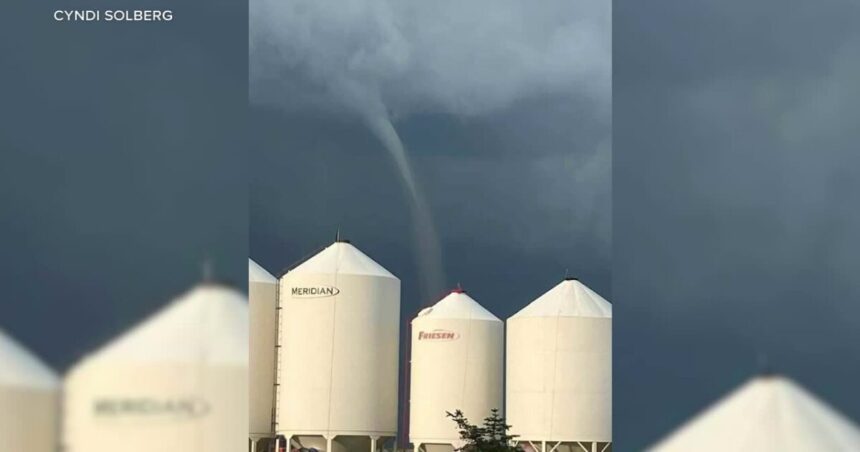GREAT FALLS — There is new information about the storm that roared across Northeast Montana on Friday, July 12, 2024.
The first Tornado Warning was issued at 6:47 p.m. for the northern part of Valley County, with the last Tornado Warning expiring at 8:15 p.m.
Tornado warnings were in effect for northeastern Valley County, southwestern Daniels County, and northwestern Roosevelt County during this 88-minute period.
Officials with the National Weather Service in Glasgow have now confirmed that there was a tornado — although some people saw two. According to the NWS, after the first tornado began to dissipate, a second tornado formed under the same storm.
It touched down about 4.3 miles east-southeast of Baylor and ended about 7.5 miles east of Larslan. The NWS says the tornado path was about 17 miles, and the width varied from 20 yards to 25 yards. It lasted from 7:10 p.m. until about 7:40 p.m., with wind speeds of more than 80 mph.
Officials noted there were two separate debris paths. one spawned from a farm, with a debris path running northeast for about 250 yards.
The second debris field spread southeast and continued through neighboring fields. The rest of the damage was relatively minor, with an uprooted small tree and some fence damage as the storm passed through.
The NWS says the tornado was rated as an EF-0, the lowest level of tornado. There were no injuries reported.
Tornadoes were not the only threat with these storms as there was also torrential rainfall, strong winds with gusts up to 60 mph, and large hail.
One witness said that baseball to softball-sized hail fell north of Larslan, and our radar indicated that hail as large as a grapefruit may have been falling at one point.
TORNADOES IN MONTANA
Montana usually has about a dozen tornadoes each year. Unlike those in “Tornado Alley” in the central part of the country, most Montana tornadoes are relatively small and usually touch down in sparsely populated areas.
Tornadoes are categorized on the Enhanced Fujita (EF) Scale from EF-0 to EF-5, based on their destructive power. EF-0 tornadoes are the weakest, while EF-5 tornadoes are the most powerful.
In 2022, an EF-2 tornado hit the community of Glentana in Valley County, causing property damage (link). The tornado was on the ground for eight miles and had an average path width of 457 yards. The maximum wind speed associated with this tornado was 120 miles per hour.
Valley County Resident
In 2016, an EF-3 tornado hit the town of Baker in southeast Montana. In 2015, a small tornado hit near Sidney in Richland County in eastern Montana, injuring one person and causing some damage.
In June 2010, a tornado hit Billings, causing significant damage to the MetraPark facility. Just several weeks later, two people were killed when a tornado struck a family ranch near Reserve in northeastern Montana.
Montana’s tornado season generally spans from late May through early August. The two key ingredients for tornado formation are low-level moisture and wind shear.
Wind shear is the change in wind direction with height up to the mid-levels of atmosphere.
Patrick Gilchrist, the warning coordination meteorologist for the National Weather Service in Glasgow, said, “When it comes to tornadoes in Montana, it’s really about moisture. So to get tornado development, we really want a moist layer right at the surface of the Earth at the lowest levels. That is provided actually by the Gulf of Mexico.”
Tornados not common in Montana – but can strike
The likelihood of tornadoes increases in eastern Montana, due to the proximity to the Gulf of Mexico, not the change in topography. Higher terrain in western Montana actually acts as ignition for severe weather outbreaks as it forces the air to move vertically creating lift in the atmosphere. The severe weather outbreaks can often last through the night, traveling as far as Minnesota.
While tornadoes are less common in central Montana, the threat still exists. There have been a few notable events in recent history. An F2 moved through Lewistown back in 1999 and a series of F3 tornadoes southeast of Big Sandy in Chouteau County back in 1988.
Damage assessments are utilized in determining the tornadoes scale, which can be difficult given the rural nature of eastern Montana.





